Recent Topics
Here, we list some recently published results of our research activities.
Jan. 2014, Relationship between Superconductivity and Antiferromagnetism in LaFe(As1-xPx)O Revealed by 31P-NMR
Nov. 2013, we have investigated the in-plane uniaxial pressure effect on the antiferromagnetic Mott insulator Ca2RuO4 from resistivity and magnetization measurements. We succeeded in inducing the ferromagnetic metallic phase at lower critical pressure than by hydrostatic pressure, indicating that the flattening distortion of the RuO6 octahedra is more easily released under in-plane uniaxial pressure. We also found a striking in-plane anisotropy in the pressure responses of various magnetic phases: Although the magnetization increases monotonically with pressure diagonal to the orthorhombic principal axes, the magnetization exhibits peculiar dependence on pressure along the in-plane orthorhombic principal axes. This peculiar dependence can be explained by a qualitative difference between the uniaxial pressure effects along the orthorhombic a and b axes, as well as by the presence of twin domain structures.
This study is published in Physical Review B.
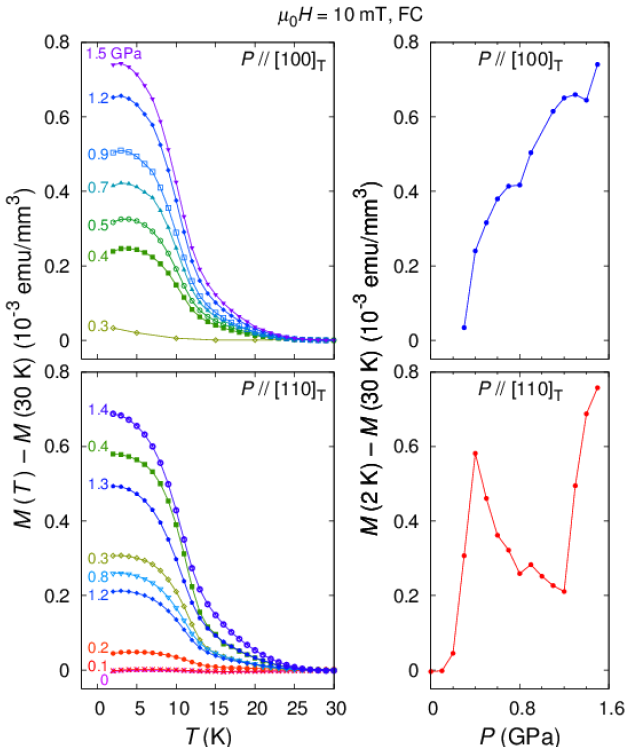
Sep. 2013, we fabricated S/N/S' micron sized topological superconducting junctions, with which the phase winding of order parameter can be effectively probed by making use of real-space topology, using Nb as a conventional superconductor S, and Ru as a Normal metal that is the part of eutectic Sr2RuO4 (used as S') single crystal. Ru-eutectic crystal has critical temperature Tc of the order of 3 K because of interfacial 3K-phase appeared around the Ru inclusion. We report that Nb/Ru/Sr2RuO4 topological superconducting-junctions exhibit unusual switching between higher and lower critical current states. It appears in the form of Voltage Oscillations between zero and non-zero voltage in I-V curves and Telegraphic noise (V(t)), which observed only below the bulk Tc of Sr2RuO4 (Tc_bulk 1.42 K). Our results cannot be explained well in the context of vortex dynamics. We developed a simple model to explain our results that based on a single circular Ru inclusion in Sr2RuO4 crystal. We consider two chiral domain walls "F" (fixed) and "M" (movable) intersecting the Ru/Sr2RuO4 interface. It results that the switching behavior is well explained by chiral-domain-wall dynamics. The switching can be partly controlled by external parameters such as temperature, magnetic field and current. These results open up a possibility to utilize the superconducting chiral domain wall motion for future novel superconducting devices.
This study is published in Scientific Reports.
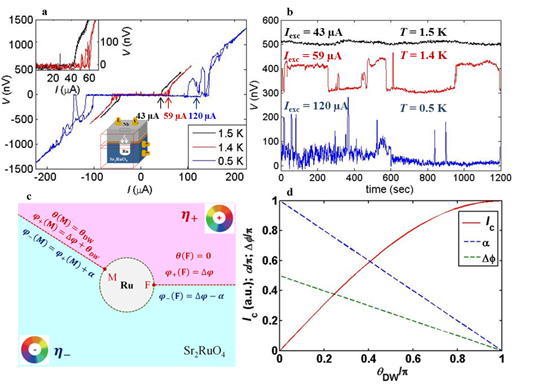
Aug. 2013, Spin susceptibility in the superconducting state of the ferromagnetic superconductor UCoGe
Aug. 2013, Extremely Large Magnetoresistance in the Nonmagnetic Metal PdCoO2
Jul. 2013, the low-temperature magnetic properties of LaCoGe with the tetragonal CeFeSi-type structure were investigated by 59Co- and 139La-nuclear magnetic resonance (NMR) and nuclear quadrupole resonance (NQR) measurements. The nuclear spin lattice relaxation rate divided by the temperature gradually increases with decreasing temperature and shows a kink at approximately 18 K, below which an inhomogeneous internal field appears at the Co nuclear site. These results indicate that antiferromagnetic ordering occurs below 18 K. However, an internal field was not observed at the La nuclear site below 18 K. Taking all NMR results into account, we conclude that spin-density-wave (SDW)-type ordering occurs, where magnetic correlations are of the checkerboard type in the ab-plane and have a long periodicity along the c-axis with inhomogeneous ordered moments pointing to the c-axis.
This study is published in J. Phys. Soc. Jpn.

May 2013, the NMR results in iron pnictides BaFe2(As1-xPx)2 and Ba(Fe1-xCox)2As2 are analyzed based on the self-consistent renormalization (SCR) spin-fluctuation theory. The temperature dependence of the NMR relaxation rate 1/T1 as well as the electrical resistivity is well reproduced by a SCR model where two-dimensional antiferromagnetic (AF) spin fluctuations are dominant. The successful description of the crossover feature from non-Fermi-liquid to Fermi-liquid behavior strongly suggests that low-lying spin fluctuations in BaFe2(As1-xPx)2 and Ba(Fe1-xCox)2As2 possess an itinerant AF nature, and that chemical substitution in the two compounds tunes the distance of these systems to an AF quantum critical point. The close relationship between spin fluctuations and superconductivity is discussed compared with the other unconventional superconductors, cuprate and heavy fermion superconductors. In addition, it is suggested that magnetism and lattice instability in these pnictides are strongly linked via orbital degrees of freedom.
This study is published in Phys. Rev. B.
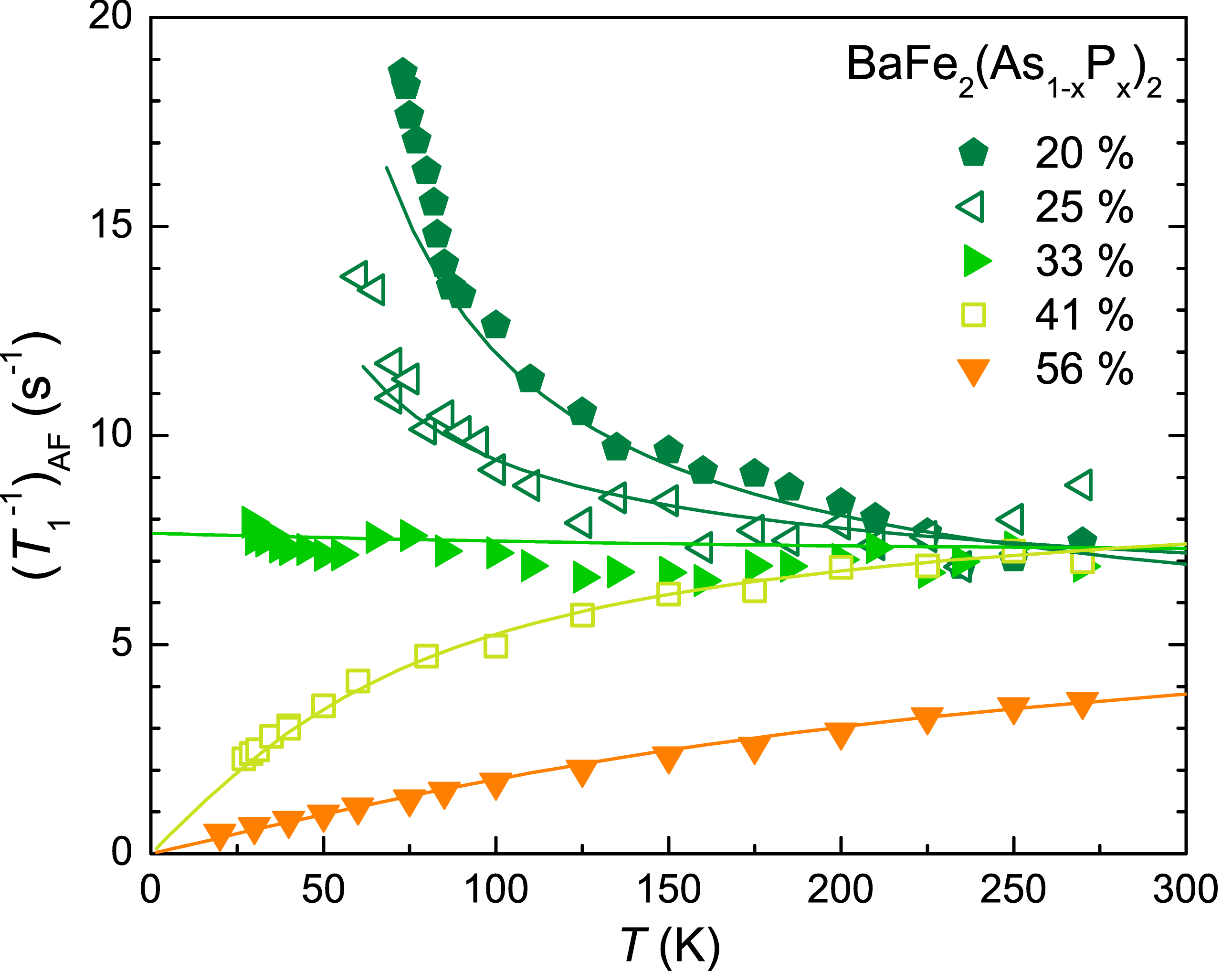
Apr. 2013, we report the systematic investigation of the specific heat of the noncentrosymmetric superconductor Li2(Pd1-xPtx)3B as a function of x. There is a large deviation of the phononic specific heat from the conventional Debye specific heat for Pt-rich samples. In contrast to the fully gapped conventional behavior for small x, a power-law temperature dependence of the electronic specific heat is observed even at x = 0.5. These results manifest a strongly anisotropic or nodal superconducting gap even at x = 0.5 and a nodal superconducting gap for x ≳ 0.9.
We thank T. Shishidou, Y. Yanase, Y. Fuseya, C. Michioka, and K. Yoshimura for fruitful discussions and useful advice. This study is published as a Rapid Communication in Physical Review B.
3B_abst.png)
s-wave superconductivity in superconducting BaTi2Sb2O revealed by 121/123Sb-NMR/nuclear quadrupole resonance measurements
Feb. 2013, we report the 121/123Sb-NMR/nuclear quadrupole resonance (NQR) measurements on the superconductor BaTi2Sb2O with a two-dimensional Ti2O square-net layer formed with Ti3+ (3d1). NQR measurements revealed that the in-plane four-fold symmetry is broken at the Sb site below TA~40 K, without an internal field appearing at the Sb site. These exclude a spin-density wave (SDW)/ charge density wave (CDW) ordering with incommensurate correlations, but can be understood with the commensurate CDW ordering at TA. The spin-lattice relaxation rate 1/T1, measured at the four-fold symmetry breaking site, decreases below superconducting (SC) transition temperature Tc, indicative of the microscopic coexistence of superconductivity and the CDW/SDW phase below TA. Furthermore, 1/T1 of 121Sb-NQR shows a coherence peak just below Tc and decreases exponentially at low temperatures. These results are in sharp contrast with those in cuprate and iron-based superconductors, and strongly suggest that its SC symmetry is classified to an ordinary s-wave state. This study is published in Physical Review B.
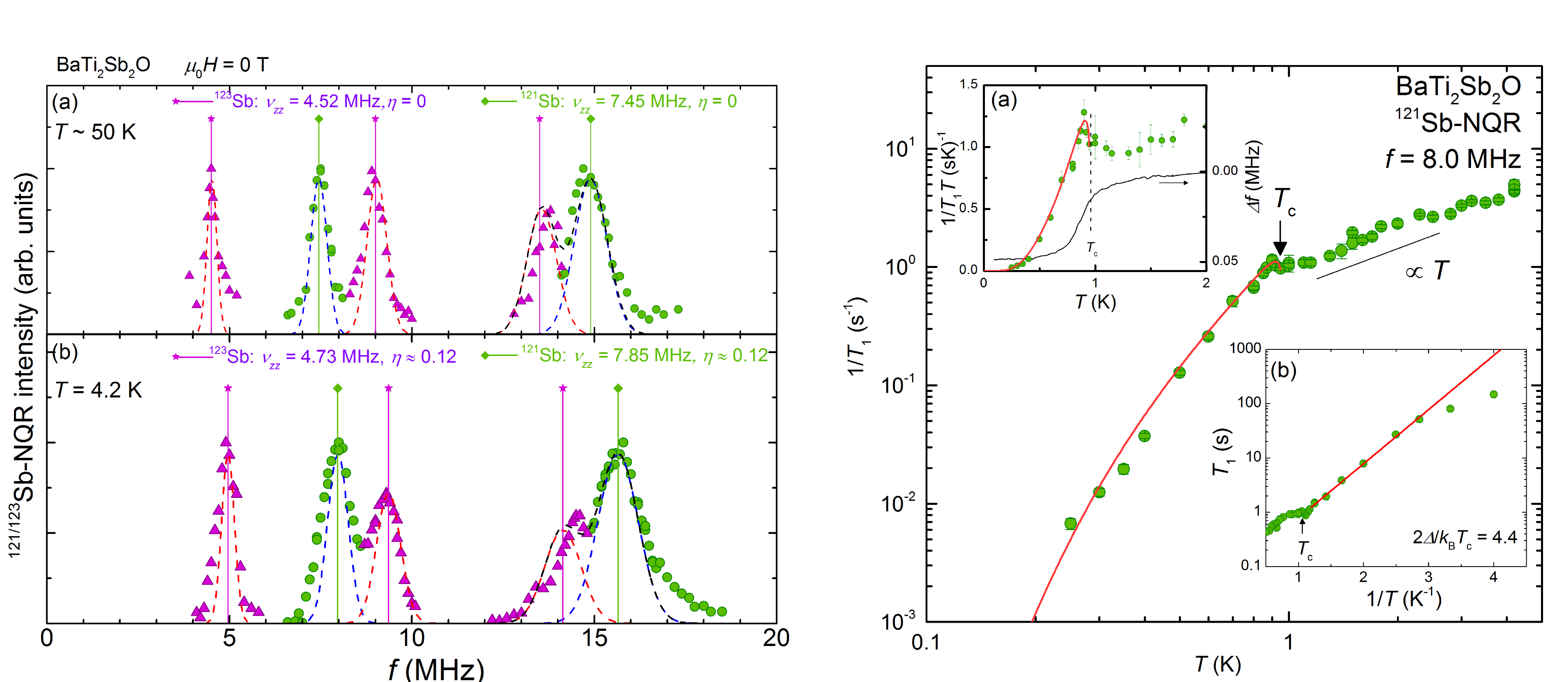
Feb. 2013, any superconductivity inevitably interact with magnetic fields, and almost always the magnetic field destabilizes superconductivity with certain ways. Thus, it is extremely important to investigate how the magnetic field interact with superconductivity, not only for scientific researches but also for industrial applications. We studied the superconducting transition of Sr2RuO4, a promising candidate of the spin-triplet superconductor, and revealed that the superconducting transition of this oxide is of the first order when the magnetic field is exactly parallel to the conducting plane of the crystal. This result is rather surprising, since, for ordinary superconductors, in-field transition is always the continuous second order transition, due to the gradual suppression of superconductivity by the penetration of quantized vortices. Only a few exceptions are known, all of which however are irrelevant for Sr2RuO4. Thus, the observed sudden destruction of superconductivity via the first-order transition evidences that the spin-triplet superconductivity in Sr2RuO4 is destabilized by an unknown mechanism. In other words, there must be novel interaction between superconductivity and magnetic field responsible for the destruction of superconductivity.
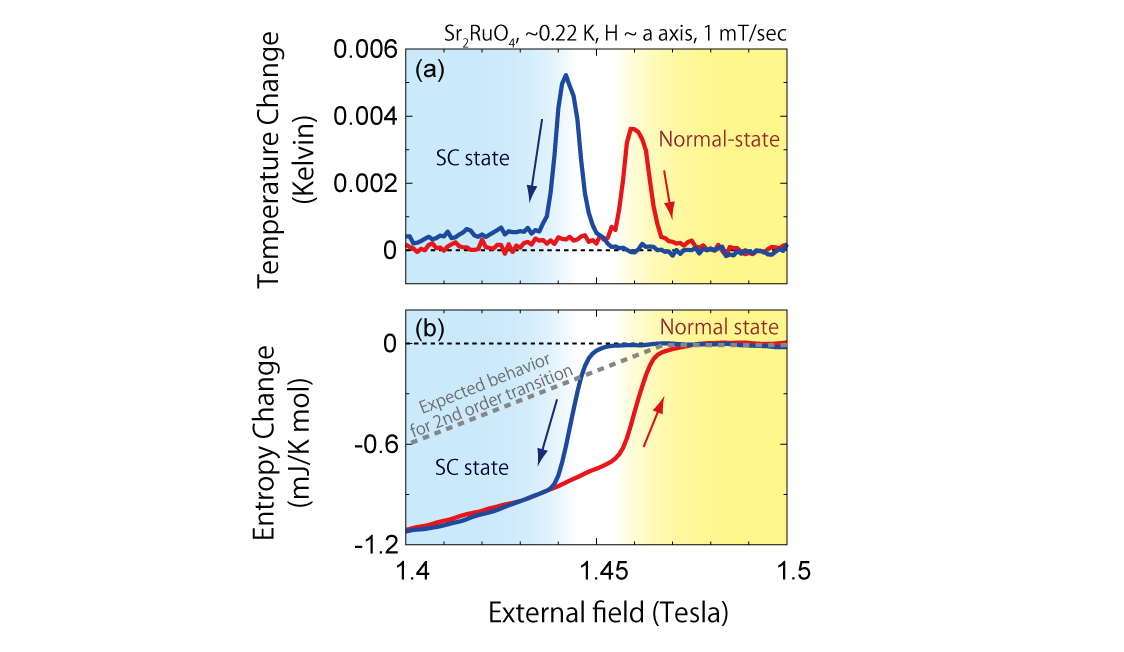
We have performed 31P-NMR measurements on Ce(Ru1-xFex)PO in order to investigate ferromagnetic (FM) quantum criticality, since a heavy-fermion (HF) ferromagnet CeRuPO with a two-dimensional structure turns into a HF paramagnet by an isovalent Fe substitution for Ru. We found that Ce(Ru0.15Fe0.85)PO shows critical fluctuations down to 0.3 K, as well as the continuous suppression of Curie temperature and the ordered moments by the Fe substitution. These experimental results suggest the presence of a FM quantum critical point (QCP) at x ~ 0.86, which is a rare example among itinerant ferromagnets. In addition, we point out that the critical behaviors in Ce(Ru0.15Fe0.85)PO share a similarity with those in YbRh2Si2, where the local criticality of f electrons has been discussed. We reveal that Ce(Ru1-xFex)PO is a new system to study FM quantum criticality in HF compounds. This study is published in Journal of the Physical Society of Japan. This paper was chosen as "Paper of Editors' Choice".
PO_2d.png)
We have performed 31P-NMR measurements on Ce(Ru1-xFex)PO in order to investigate ferromagnetic (FM) quantum criticality, since a heavy-fermion (HF) ferromagnet CeRuPO with a two-dimensional structure turns into a HF paramagnet by an isovalent Fe substitution for Ru. We found that Ce(Ru0.15Fe0.85)PO shows critical fluctuations down to 0.3 K, as well as the continuous suppression of Curie temperature and the ordered moments by the Fe substitution. These experimental results suggest the presence of a FM quantum critical point (QCP) at x ~ 0.86, which is a rare example among itinerant ferromagnets. In addition, we point out that the critical behaviors in Ce(Ru0.15Fe0.85)PO share a similarity with those in YbRh2Si2, where the local criticality of f electrons has been discussed. We reveal that Ce(Ru1-xFex)PO is a new system to study FM quantum criticality in HF compounds. This study is published in Physical Review Letters.
PO.png)
We report normal and superconducting properties of the Rashba-type noncentrosymmetric compound CaIrSi3 using single crystalline samples with nearly 100% superconducting volume fraction. The electronic density of states revealed by the hard x-ray photoemission spectroscopy can be well explained by the relativistic first-principles band calculation. This indicates that strong spin-orbit interaction indeed affects the electronic states of this compound. The obtained H -T phase diagram exhibits only approximately 10% anisotropy, indicating that the superconducting properties are almost three dimensional. Nevertheless, strongly anisotropic vortex pinning is observed. We thank Taichi Matsuda, Hiroaki Ikeda, Y. Yanase, S. Fujimoto, D. C. Peets, M. Kriener, F. Kneidinger, and E. Bauer for fruitful discussions. This study is published as a Regular article of Physical Review B.
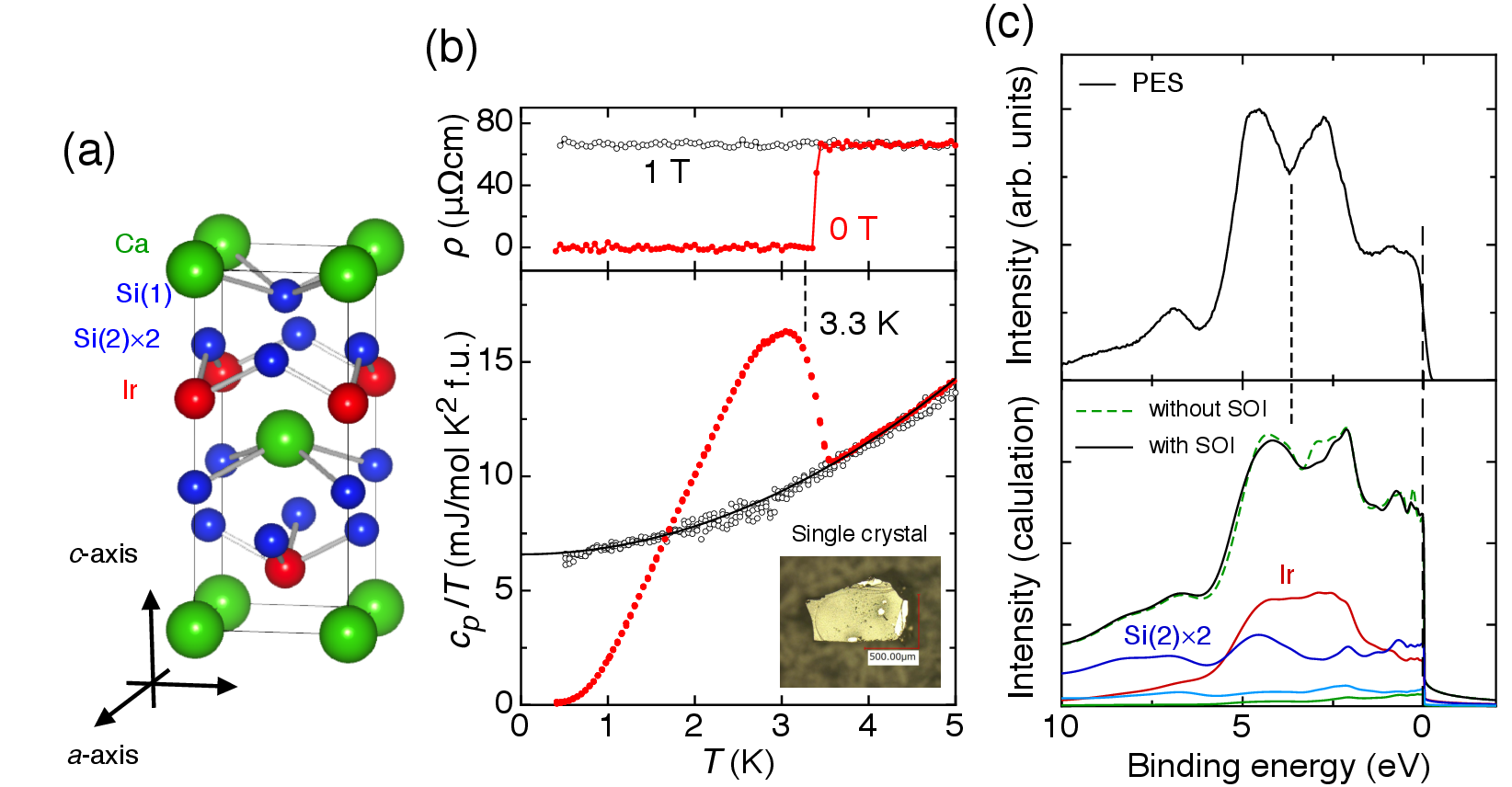
Nov. 2012, Large spin-orbit splitting and weakly anisotropic superconductivity revealed with single-crystalline noncentrosymmetric CaIrSi3
Jul. 2012, Study of metamagnetic critical phenomena in UCoAl
Jun. 2012, Pressure Study of the Noncentrosymmetric 5d-Electron Superconductors CaMSi3(M=Ir, Pt)
Feb. 2012, Microscopic Evidence of Direct Coupling between Magnetic and Superconducting Order Parameters in BaFe2(As1-xPx)2
Feb. 2012, Superconductivity Induced by Longitudinal Ferromagnetic Fluctuations in UCoGe
Jan. 2012, Evaluation of Spin-Triplet Superconductivity in Sr2RuO4
Dec. 2011, Metamagnetic Behavior and Kondo Breakdown in Heavy-Fermion CeFePO
Jun. 2011, 59Co-Nuclear Quadrupole Resonance and Nuclear Magnetic Resonance Studies on YCoGe -Comparison between YCoGe and UCoGe-
May 2011, Non-magnetic pair-breaking effect on La(Fe1-xZnx)AsO0.85 studied by NMR and NQR
Jan. 2011, Crystallographic and superconducting properties of the fully gapped noncentrosymmetric 5d-electron superconductors CaMSi3 (M=Ir, Pt)
Nov. 2010, Anisotropic Magnetic Fluctuations in the Ferromagnetic Superconductor UCoGe Studied by Direction-Dependent 59Co NMR Measurements
Sep. 2010, Unconventional Superconductivity and Antiferromagnetic Quantum Critical Behavior in the Isovalent-Doped BaFe2(As1-xPx)2
Jun. 2010, Stripe antiferromagnetic correlations in LaFeAsO1-xFx probed by 75As NMR
Feb. 2010, Microscopic Coexistence of Ferromagnetism and Superconductivity in Single-Crystal UCoGe
Jan. 2010, 31P and 75As NMR evidence for a residual density of states at zero energy in superconducting BaFe2(As0.67P0.33)2
Oct. 2009, Angular dependence of the upper critical field of Sr2RuO4
Oct. 2009, Large enhancement of 3-K phase superconductivity in the Sr2RuO4-Ru eutectic system by uniaxial pressure
Jan. 2009, Heavy-Mass Behavior of Ordered Perovskites ACu3Ru4O12 (A = Na, Ca, La)
Aug. 2008, Spin Dynamics in Iron-Based Layered Superconductor (La0.87Ca0.13)FePO Revealed by 31P and 139La NMR Studies
Jul. 2008, Specific heat and electronic states of superconducting boron-doped silicon carbide
Jul. 2008, Evolution from Itinerant Antiferromagnet to Unconventional Superconductor with Fluorine Doping in LaFeAs(O1-xFx) Revealed by 75As and 139La Nuclear Magnetic Resonance
Jun. 2008, Multiple superconducting transitions in the Sr3Ru2O7 region of Sr3Ru2O7-Sr2RuO4 eutectic crystals
Apr. 2008, Magnetic-Field Variations of the Pair-Breaking Effects of Superconductivity in (TMTSF)2ClO4
Mar. 2008, Anomalous In-Plane Anisotropy of the Onset of Superconductivity in (TMTSF)2ClO4
Jan. 2008, Low-lying excitations at the rare-earth site due to the rattling motion in the filled skutterudite LaOs4Sb12 revealed by 139La NMR and 121/123Sb NQR
Sep. 2007, Roles of High-Frequency Optical Phonons in the Physical Properties of the Conductive Delafossite PdCoO2
Jun. 2007, Quantum critical behavior in superconducting Nax(H3O)zCoO2·yH2O observed in a high-field Co NMR experiment
Aug. 2006, Field-induced confinement in (TMTSF)2ClO4 under accurately aligned magnetic fields
Apr. 2006, Coherent Behavior and Nonmagnetic Impurity Effects of Spin Disordered State in NiGa2S4
Nov. 2005, Type-I superconductivity of the layered silver oxide Ag5Pb2O6